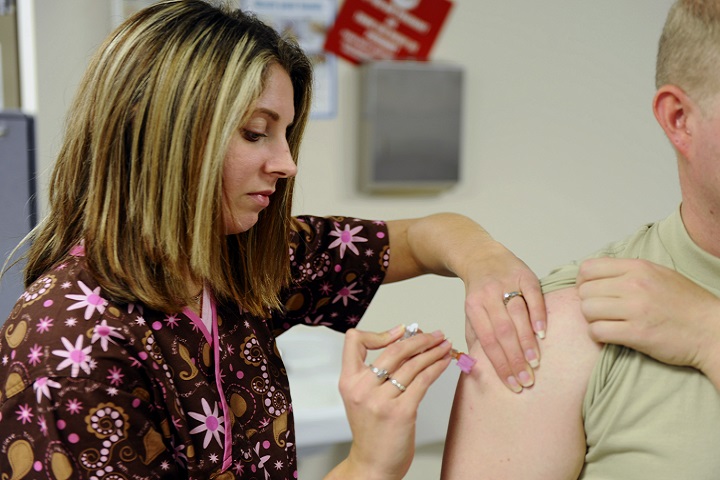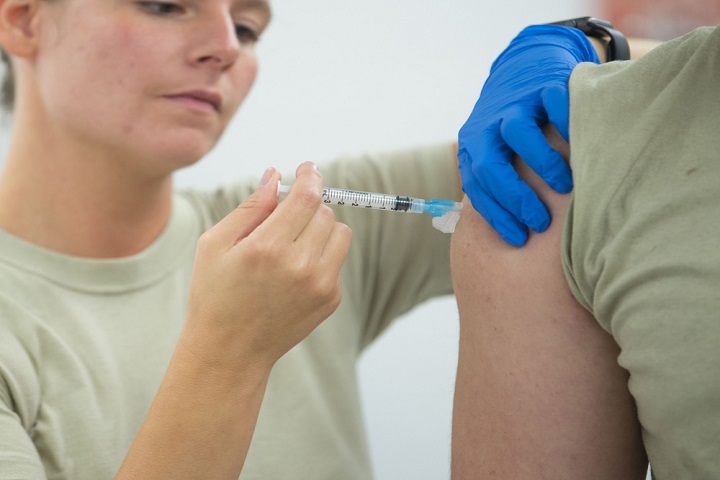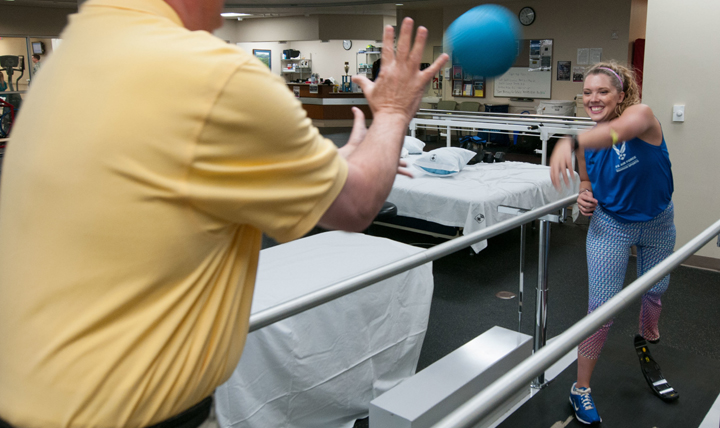
Smoking in disguise: Electronic smoking devices labeled ‘healthy’ can be misleading

Vaping and using e-cigarettes have become very popular in recent years, but users should be aware of known risks and potential dangers. Electronic nicotine delivery systems use noncombustible tobacco products and typically contain nicotine, flavorings, and other chemicals. (DoD file photo)
FALLS CHURCH, Va. — Cigarette smoking has been around since the ninth century. Today, many people are using battery-powered devices designed to mimic the habit while delivering fewer toxins. Experts, however, warn that regarding these devices as “natural” or “healthy” can be misleading.
“Many people think e-cigarettes are safe and without any sort of harm, because they’re not a conventional cigarette,” said Army Lt. Col. Sally DelVecchio, chief of Pulmonary Critical Care Service at Fort Belvoir Community Hospital in Northern Virginia. “While there may be fewer toxins in e-cigarettes, people should still be aware that there can be harmful toxins in the product liquid.”
Electronic nicotine delivery systems use noncombustible tobacco products and typically contain nicotine, flavorings, and other chemicals. They’re known as e-cigarettes, vaporizers, vape pens, hookah pens, and e-pipes. These devices can mimic traditional cigarettes and pipes, or they can look like everyday objects, such as pens or USB memory sticks.
In 2016, the Office of the U.S. Surgeon General released the first comprehensive report by a federal agency on e-cigarette use among older children and young adults. It said more than a quarter of students grades 6-12, and more than a third of young adults, have tried e-cigarettes, which is now the most common form of tobacco used by middle school and high school students in the United States.
In e-cigarettes, nicotine is delivered through a liquid called e-juice, which turns into vapor when using the devices. DelVecchio said the liquid can come in various flavors, which is attractive for the young population.
Regina Watson, health promotion program manager for the Air Force Medical Support Agency, warned that there are misconceptions about what’s in these products and the harm they can do. Some people may believe that e-cigarettes don’t contain nicotine, because they don’t have combustible tobacco, which is found in traditional cigarettes. But e-cigarettes are a nicotine product, Watson said.
“In some cases, it might have more [nicotine] than regular cigarettes, but it’s difficult to know, because it’s largely unregulated,” she said.
According to the Centers for Disease Control and Prevention, e-cigarette aerosol can include nicotine, cancer-causing chemicals, ultrafine particles, and heavy metals such as nickel, tin, and lead. It can also include flavorings like diacetyl, which is a chemical linked to serious lung disease.
E-cigarettes also increase the possibility of negatively affecting brain development and respiratory health, the OSG said. Nicotine affects the development of the brain’s reward system, which includes brain circuits that affect attention and learning. Other risks include mood disorders and permanent problems with impulse control.
DelVecchio warned that while more research needs to be done on the long-term health effects of e-cigarettes and vaping, bronchiolitis obliterans has been linked to these products. This disease occurs when e-cigarette use triggers an immune system response, causing inflammation in the lungs. It’s unknown whether the inflammation is long-term or if any additional damage disappears over time, DelVecchio said.
“I believe more and more places are starting to acknowledge that vaping and e-cigarettes are potentially just as harmful as secondhand smoke,” she said.
More than 460 different e-cigarette brands are available, according to the National Institute on Drug Abuse. Watson warned that many vaping products are not FDA-approved, since the contents, including chemicals and substances in flavoring, aren’t fully known, making the safety level difficult to determine.
According to NIDA, about 66 percent of teenagers who use e-cigarettes believe their products only contain flavoring, while nearly 14 percent report not knowing what’s in them, and only roughly 13 percent believe they contain nicotine. Although some e-cigarette brands are FDA-approved, other vaping products and e-cigarettes are not regulated. Long-term data on the safety of all of these products is not available, since they are still relatively new, DelVecchio said.
Research shows e-cigarette use among youth can lead to traditional tobacco use, which is known to cause disease and premature death, said Watson.
Additional information on e-cigarettes can be found through the Centers for Disease Control and Prevention and National Institutes of Health. Resources for quitting smoking can be found through the Department of Defense’s UCanQuit2 campaign.
“Even though you may not feel like you’re smoking with an e-cigarette, you can be putting more harm in your body than you realize,” said Watson. “It’s important to stay informed and do your research.”
Say ‘Shoo’ to the flu with TRICARE
Article
9/26/2018

Flu viruses are serious, contagious viruses that can lead to hospitalization or even death
HPV
Infographic
9/24/2018

Genital human papillomavirus (HPV) is the most common sexually transmitted infection (STI) in the U.S., and is the second most frequently diagnosed STI in U.S. military service members. Currently, HPV is not a mandatory vaccine for U.S. military service. However, it is encouraged and offered to service members.
Drowning
Infographic
9/24/2018

Service members are at risk for unintentional drownings during training, occupational activities, and off-duty recreation. In the U.S., unintentional drowning ranks as the fifth leading cause of unintentional injury death and accounted for an average of 3,558 deaths (non-boating related) annually between 2007 and 2016. The current analysis extends ...
HIV
Infographic
9/24/2018

As part of the U.S. military’s total-force HIV screening program, civilian applicants for military service are screened for antibodies to HIV during pre-accession medical examinations. Infection with HIV is medically disqualifying for entry into U.S. military service. Since 1986, all members of the active and reserve components of the U.S. Armed ...
Norovirus
Infographic
8/27/2018

Beginning in 2011, the Operational Infectious Diseases (OID) laboratory at the Naval Health Research Center has undertaken routine surveillance of four U.S. military training facilities to systematically track the prevalence of acute gastroenteritis and to establish its etiologies among U.S. military recruits.
Staphylococcus
Infographic
8/27/2018

Staphylococcus: Staphylococcus aureus is a major cause of skin and soft tissue infection (SSTI). Military personnel in congregate settings (e.g., training, deployment) are at increased risk for S. aureus colonization and SSTI. For a 7-month period in 2016, an observational cohort study of S. aureus colonization and SSTI among U.S. Navy submariners was ...
Heat rash is common when the mercury climbs
Article
8/14/2018

Anyone can be affected, including children and adults
The things head lice carry: Stigma and hassle, but no harm
Article
7/31/2018

Lice – a common affliction in school children – are gross but harmless
Acute Injuries
Infographic
7/25/2018

Service members in the U.S. Armed Forces frequently engage in high levels of physical activity to perform their duties, and such activity can potentially result in training- or duty-related injury. This report summarizes the incidence, trends, types, external causes, and dispositions of acute injuries among active component U.S. service members over ...
Food Allergy
Infographic
7/25/2018

Individuals with a history of food-allergy anaphylaxis or a systemic reaction to food do not meet military accession or retention standards and require a waiver in order to serve in the military. First-line treatment for anaphylaxis includes rapid administration of epinephrine.
Preparing for travel can prevent illness
Article
7/18/2018

Experts encourage travelers to be proactive about their travel medicine needs, including learning about the health risks associated with the destination and checking with their doctor to make sure they’re in good health
Deep vein thrombosis: What you need to know
Article
4/9/2018

Everyone’s potentially at risk, vascular surgeon says
‘Kissing disease’ exhausting, but it strikes only once
Article
2/15/2018

Mononucleosis: Learn how virus spreads, who’s most vulnerable
Rocky and Elmo want providers to "Watch. Ask. Share."
Article
2/12/2018

How DHA teamed with Sesame Street to help care for military families
Caring for skin goes deeper than applying lotion
Article
2/6/2018

The many critical roles of a military dermatologist






















.png)











No hay comentarios:
Publicar un comentario